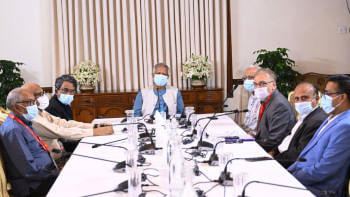Twice as many men use cellphone than women

Eighty percent of male youth in rural and urban areas have their own mobile phones, whereas only 40 percent of the female youth do so. On the other hand, only six percent of households have access to computers and less than four percent of women have ever used a computer.
The findings were revealed at a webinar titled "Gender and Youth Inclusiveness in Technology in Bangladesh," which was jointly organised by South Asian Network on Economic Modeling (Sanem) and ActionAid Bangladesh. The paper was presented by Mahtab Uddin, research economist of Sanem. Prof Selim Raihan and Sakil Ahmmed were co-authors for this paper.
He pointed out that in case of access to computers, Bangladesh lags behind other South Asian countries. Fifty percent urban households have computers while the ratio falls to 30 percent in rural areas, while only 10 percent of women have ever used the internet.
He also said that 24 percent of the females from the poorest income decile own mobile phones, while the rate is 73 percent for the richest income decile. On the other hand 72 percent of male youths from households in the poorest income decile own a mobile phone compared to the 92 percent in the top income decile.
"It is evident that the male-female gap is 44 percentage points in the poorest income decile and 19 percentage points in the richest income decile," said Mahtab Uddin.
Chief guest of the program, Deputy Minister of Education Mohibul Hassan Chowdhury said that gender discrimination in technology is often a result of patriarchal and conservative culture.
"When women use technology they often have to face stigma and digital harassment, without a change in [people's] mentality it would be difficult to overcome this discrimination," he said. Acknowledging the growing spread of fundamentalist, misogynistic and anti-Liberation War ideas online, he called on all to work together to overcome the stigmas and uphold social values and tolerance.
Anir Chowdhury, policy adviser of a2i, shared findings from a2i's research and explained that despite efforts from the government to spread education through digital platforms, it has been difficult to include certain demographics such as low-income groups, women, persons with disabilities, displaced people and people in remote areas.
The webinar was chaired by ActionAid Country Director Farah Kabir and moderated by Research Director of Sanem, Prof Sayema Haque Bidisha. Special remarks were delivered by Prof Selim Raihan, Executive Director of Sanem. Joint Secretary (technical) of Education Ministry Ayatul Islam; Deputy Secretary of Youth and Sports Ministry Md Sayed Ali, and Senior Vice President of Bangladesh Association of Software and Information Services (BASIS) Farhana Rahman were also present.

 For all latest news, follow The Daily Star's Google News channel.
For all latest news, follow The Daily Star's Google News channel. 



Comments